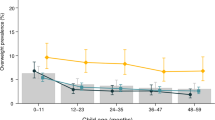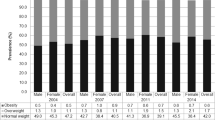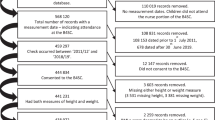Abstract
Background:
After several decades of increasing prevalence, recent evidence suggests a levelling of obesity rates in some groups, although little is known about trends in children under 5 years of age.
Aim:
To investigate the prevalence, trends and sociodemographic correlates of overweight and obesity in Australian preschool children between 1999 and 2007.
Methods:
Child anthropometric and demographic data were extracted from records of routine maternal and child health consultations for children aged 2 and 3.5 years in the Australian state of Victoria. Data were analysed for prevalence of overweight and obesity (according to International Obesity Task Force definitions), trends in prevalence from 1999 to 2007 and sociodemographic correlates of prevalence and trends.
Results:
Complete data were available for 129 266 2-year-old children and 96 164 3.5-year-old children from 41 local government areas across Victoria. Combined prevalence of overweight and obesity decreased significantly between 1999 and 2007 in 3.5-year-old children (by 3.1% points from 18.5 to 15.4%) and in 2-year-old children (1.1% point decrease from 13.5 to 12.4%). There was no accompanying increase in rates of underweight. Decreases were more pronounced in areas of lower socioeconomic status (SES). Prevalence of both overweight and obesity was consistently higher across time in the older group of children, in the lowest quartile of SES and among girls.
Conclusions:
Prevalence of overweight and obesity in preschool children in Victoria has decreased significantly between 1999 and 2007, whereas socioeconomic disparities have narrowed. Further research is needed to understand the reasons for the decreasing prevalence, and to better evaluate existing and emerging health promotion initiatives. Such evidence will be important to build on the findings of this study and to transfer lessons learnt to other population groups.
This is a preview of subscription content, access via your institution
Access options
Subscribe to this journal
Receive 12 print issues and online access
$259.00 per year
only $21.58 per issue
Buy this article
- Purchase on Springer Link
- Instant access to full article PDF
Prices may be subject to local taxes which are calculated during checkout


Similar content being viewed by others
References
Wang Y, Lobstein T . Worldwide trends in childhood overweight and obesity. Int J Pediatr Obes 2006; 1: 11–25.
Berghofer A, Pischon T, Reinhold T, Apovian CM, Sharma AM, Willich SN . Obesity prevalence from a European perspective: a systematic review. BMC Public Health 2008; 8: 200.
Cameron AJ, Welborn TA, Zimmet PZ, Dunstan DW, Owen N, Salmon J et al. Overweight and obesity in Australia: the 1999-2000 Australian Diabetes, Obesity and Lifestyle Study (AusDiab). Med J Aust 2003; 178: 427–432.
Popkin BM . The nutrition transition and obesity in the developing world. J Nutr 2001; 131: 871S–873S.
Hedley AA, Ogden CL, Johnson CL, Carroll MD, Curtin LR, Flegal KM . Prevalence of overweight and obesity among US children, adolescents, and adults, 1999–2002. JAMA 2004; 291: 2847–2850.
Singh AS, Mulder C, Twisk JW, van Mechelen W, Chinapaw MJ . Tracking of childhood overweight into adulthood: a systematic review of the literature. Obes Rev 2008; 9: 474–488.
Magarey AM, Daniels LA, Boulton TJ, Cockington RA . Predicting obesity in early adulthood from childhood and parental obesity. Int J Obes Relat Metab Disord 2003; 27: 505–513.
de Onis M, Wijnhoven TM, Onyango AW . Worldwide practices in child growth monitoring. J Pediatr 2004; 144: 461–465.
Armstrong J, Reilly JJ . The prevalence of obesity and undernutrition in Scottish children: growth monitoring within the Child Health Surveillance Programme. Scott Med J 2003; 48: 32–37.
Kalies H, Lenz J, von Kries R . Prevalence of overweight and obesity and trends in body mass index in German pre-school children, 1982–1997. Int J Obes Relat Metab Disord 2002; 26: 1211–1217.
van den Hurk K, van Dommelen P, van Buuren S, Verkerk PH, Hirasing RA . Prevalence of overweight and obesity in the Netherlands in 2003 compared to 1980 and 1997. Arch Dis Child 2007; 92: 992–995.
Canning PM, Courage ML, Frizzell LM . Prevalence of overweight and obesity in a provincial population of Canadian preschool children. CMAJ 2004; 171: 240–242.
Irigoyen M, Glassman ME, Chen S, Findley SE . Early onset of overweight and obesity among low-income 1- to 5-year olds in New York City. J Urban Health 2008; 85: 545–554.
Bundred P, Kitchiner D, Buchan I . Prevalence of overweight and obese children between 1989 and 1998: population based series of cross sectional studies. BMJ 2001; 322: 326–328.
Jones SE, James-Ellison M, Young S, Gravenor MB, Williams R . Monitoring trends in obesity in South Wales using routine data. Arch Dis Child 2005; 90: 464–467.
Blomquist HK, Bergstrom E . Obesity in 4-year-old children more prevalent in girls and in municipalities with a low socioeconomic level. Acta Paediatr 2007; 96: 113–116.
Department of Education and Early Childhood Development. Annual Data Reports for Maternal and Child Health. Early Years Services: Data Collection and Reports. State of Victoria Department of Education and Early Childhood Development: Melbourne, Victoria, 2007.
Cole TJ, Bellizzi MC, Flegal KM, Dietz WH . Establishing a standard definition for child overweight and obesity worldwide: international survey. BMJ 2000; 320: 1240–1243.
Cole TJ, Flegal KM, Nicholls D, Jackson AA . Body mass index cut offs to define thinness in children and adolescents: international survey. BMJ 2007; 335: 194.
Pan H, Cole T . lmsGrowth Program, a Microsoft Excel add-in to access growth references based on the LMS method. In. version 2.4, 2007. Available from: http://www.healthforallchildren.co.uk/, 2007.
World Health Organisation. WHO: The WHO Child Growth Standards Software. Available at http://www.who.int/childgrowth/en/, 2008.
Australian Bureau of Statistics. 2033.0.55.001—Census of Population and Housing: Socio-Economic Indexes for Areas (SEIFA), Australia—Data Cube only, 2001. Australian Bureau of Statistics, Commonwealth of Australia: Canberra, 2003.
Australian Bureau of Statistics. 2039.0—Information Paper: Census of Population and Housing—Socio-Economic Indexes for Areas, Australia, 2001. Commonwealth of Australia: Canberra, 2003.
Office for Children Victorian Government Department of Human Services. Maternal and Child Health Program Guide. Victorian Government Department of Human Services: Melbourne, Victoria, 2006, pp 21–22.
Sanigorski AM, Bell AC, Kremer PJ, Swinburn BA . High childhood obesity in an Australian population. Obesity (Silver Spring) 2007; 15: 1908–1912.
Commonwealth Scientific Industrial Research Organisation (CSIRO), University of South Australia. 2007 Australian National Children's Nutrition and Physical Activity Survey: Main Findings. Commonwealth of Australia: Canberra, 2008.
Wake M, Hardy P, Canterford L, Sawyer M, Carlin JB . Overweight, obesity and girth of Australian preschoolers: prevalence and socio-economic correlates. Int J Obes (Lond) 2007; 31: 1044–1051.
Ogden CL, Carroll MD, Curtin LR, McDowell MA, Tabak CJ, Flegal KM . Prevalence of overweight and obesity in the United States, 1999-2004. JAMA 2006; 295: 1549–1555.
Flegal K, Ogden C, Wei R, Kuczmarski R, Johnson C . Prevalence of overweight in US children: comparison of US growth charts from the Centers for Disease Control and Prevention with other reference values for body mass index. Am J Clin Nutr 2001; 73: 1086–1093.
Romon M, Duhamel A, Collinet N, Weill J . Influence of social class on time trends in BMI distribution in 5-year-old French children from 1989 to 1999. Int J Obes (Lond) 2005; 29: 54–59.
Matthiessen J, Velsing Groth M, Fagt S, Biltoft-Jensen A, Stockmarr A, Andersen JS et al. Prevalence and trends in overweight and obesity among children and adolescents in Denmark. Scand J Public Health 2008; 36: 153–160.
Vaska V, Volkmer R . Increasing prevalence of obesity in South Australian 4-year-olds: 1995–2002. J Paediatr Child Health 2004; 40: 353–355.
Bergstrom E, Blomquist HK . Is the prevalence of overweight and obesity declining among 4-year-old Swedish children? Acta Paediatr 2009; 98: 1956–1958.
Rokholm B, Baker JL, Sorensen TI . The levelling off of the obesity epidemic since the year 1999—a review of evidence and perspectives. Obes Rev 2010; 11: 835–846.
Sundblom E, Petzold M, Rasmussen F, Callmer E, Lissner L . Childhood overweight and obesity prevalences levelling off in Stockholm but socioeconomic differences persist. Int J Obes (Lond) 2008; 32: 1525–1530.
Sjoberg A, Lissner L, Albertsson-Wikland K, Marild S . Recent anthropometric trends among Swedish school children: evidence for decreasing prevalence of overweight in girls. Acta Paediatr 2008; 97: 118–123.
Victorian Government Department of Education and Early Childhood Development. Best start program overview. Available at http://www.education.vic.gov.au/ecsmanagement/beststart/. State Government of Victoria: Melbourne, 2007.
Lady Gowrie Child Centre Inc. Start right eat right award. Available at: http://www.gowrie-melbourne.com.au/. Gowrie Victoria: Melbourne, 2008.
Diabetes Australia Victoria. The cancer council Victoria. Kids—go for your life program overview. Available at: http://www.goforyourlife.vic.gov.au/hav/articles.nsf/pracpages/Kids_Go_for_your_life?Open. Victorian State Government: Melbourne, Victoria, 2008.
Bell AC, Simmons A, Sanigorski AM, Kremer PJ, Swinburn BA . Preventing childhood obesity: the sentinel site for obesity prevention in Victoria, Australia. Health Promot Int 2008; 23: 328–336.
Dental Health Services Victoria. Smiles 4 miles: overview. Available at http://www.dhsv.org.au/content.asp?z=3&c=11&p=238, 2008.
Victorian Government Department of Human Services Public Health Division. What's there to eat?: The practical guide to feeding families. Available at http://www.health.vic.gov.au/nutrition/child_nutrition/eat.htm. DHS: Melbourne, Victoria, 2001.
Amir LH, Forster DA, McLachlan HL, Moorhead AM, Chamberlain CR, McKay HJ . Breastfeeding in Victoria: A Report. Mother & Child Health Research, La Trobe University.on behalf of the Department of Education and Early Childhood Development, Child and Adolescent Health and Wellbeing Division, State Government of Victoria: Melbourne, 2010.
Monasta L, Lobstein T, Cole TJ, Vignerova J, Cattaneo A . Defining overweight and obesity in pre-school children: IOTF reference or WHO standard? Obes Rev 2010; doi:10.1111/j.1467-789X.2010.00748.x.
Acknowledgements
We acknowledge the support and assistance of the Office for Children, State Government of Victoria Department of Education and Early Childhood Development and the coordinators of Maternal and Child Health in participating LGAs. MSN was supported by the Australian Research Council's Australian Postgraduate Award (project number LP0560400). AMdS-S is supported by a National Health and Medical Research Council Capacity Building grant, and the Jack Brockhoff Child Health and Wellbeing program.
Author information
Authors and Affiliations
Corresponding author
Ethics declarations
Competing interests
The authors declare no conflict of interest.
Rights and permissions
About this article
Cite this article
Nichols, M., Silva-Sanigorski, A., Cleary, J. et al. Decreasing trends in overweight and obesity among an Australian population of preschool children. Int J Obes 35, 916–924 (2011). https://doi.org/10.1038/ijo.2011.64
Received:
Revised:
Accepted:
Published:
Issue Date:
DOI: https://doi.org/10.1038/ijo.2011.64



